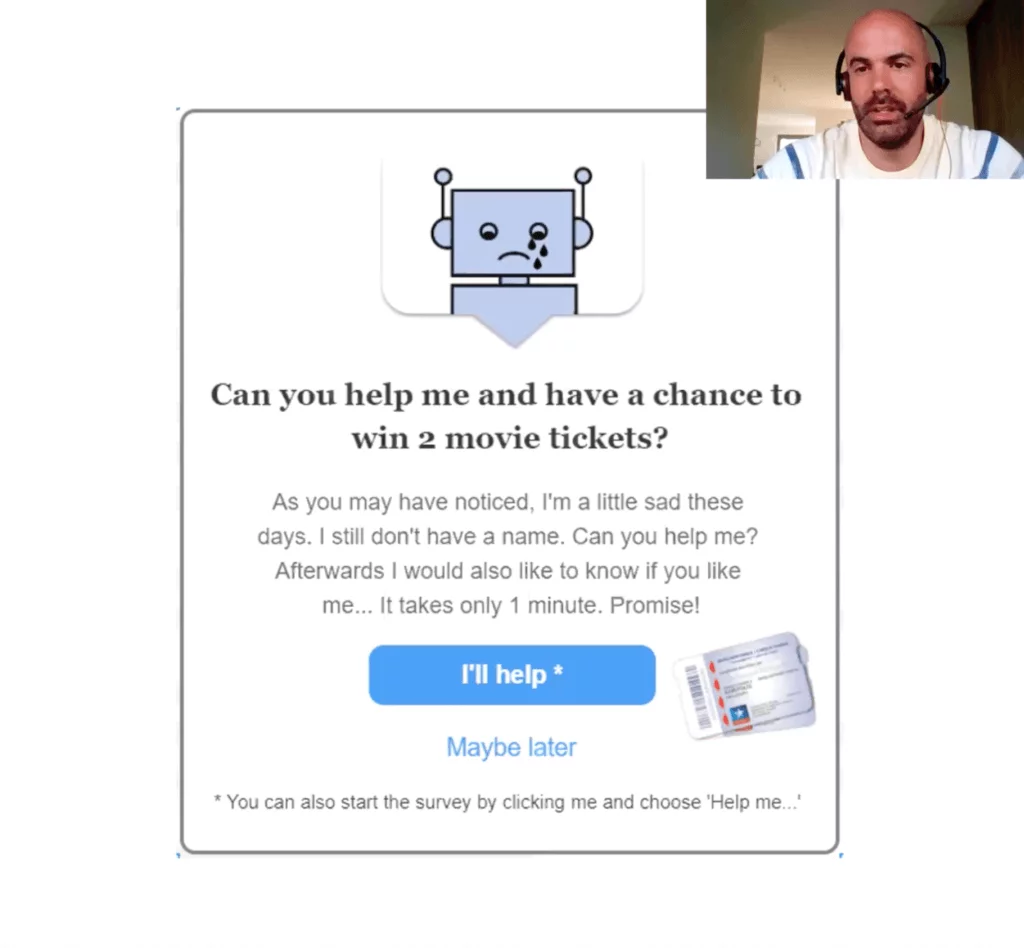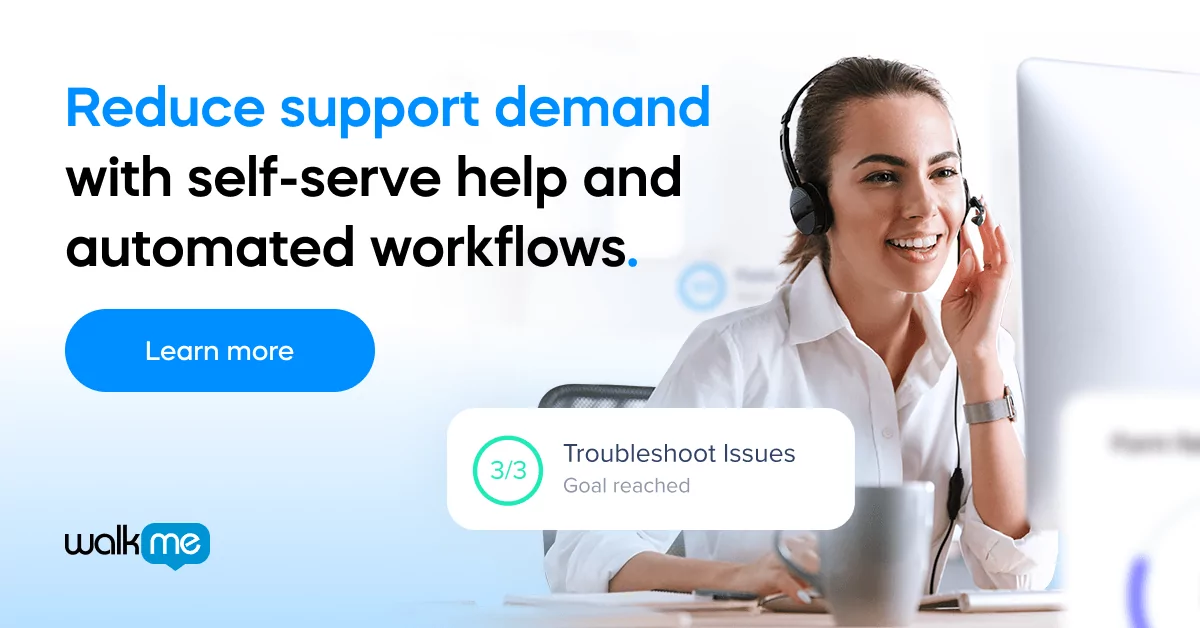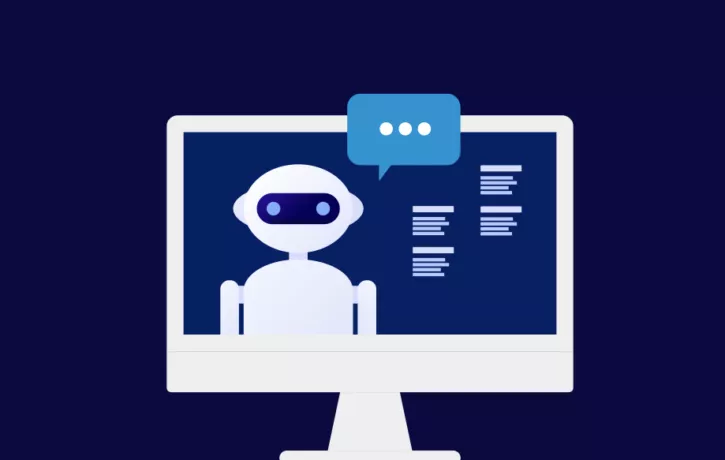Let’s talk about customer satisfaction.
A frazzled customer calls the support line of your software service. The customer has spent the better part of an hour trying to complete a process and can’t figure it out. By the time your support person answers, they need to have a solution ready and waiting.
In reality, the conversation that ensues is often long and tedious. The support person needs to understand exactly what the issue is, asking a series of often repetitive questions, and then needs to determine the solution. Implementing the solution correctly involves yet another process. By the end of this support call, the customer rarely feels satisfied, and chances are the support person feels pretty defeated as well. With the complexity of software exponentially evolving, it’s impossible for any human being to remember and support all possible processes.

The digital era has already demanded a generation of digitally-enabled users. But in order to support the users of all services, which now include pretty much every industry (from banking to retail to doctor visits), organizations and the individuals who drive them, need the highest level of automated support in order to deliver and maintain customer success.
A solution that explains and implements complex processes
If the goal of the support and service team is to have the answers to questions and the solutions to problems, how can that information be aggregated and available for employees instantly? WalkMe’s ActionBot was designed for one purpose: to hand employees the exact information that they need at the exact moment they need it, on a UX silver platter.
ActionBot “understands” what users want to do and automates their tasks for them. This level of process delivery, presentation, and then implementation eliminates confusion, errors, and frustration while also cutting the amount of time that it takes to get processes done.
By using ActionBot’s intuitive chat-interface, users are able to complete tasks without any training, even across multiple software tools. Users don’t need need to navigate sophisticated enterprise management systems, fill in complex forms, or struggle through difficult processes.
Since ActionBot is built using the WalkMe Editor and requires no R&D effort, and it can be placed on any web application where users engage in day-to-day activities. Because it completes tasks using the UI of any existing software, there are no APIs required for implementation. So any process a user can complete can be automated by ActionBot.
The bottom line is that the impact of WalkMe’s ActionBot on employee efficiency, productivity, and performance is huge, and this level of streamlined process completion directly affects customer success. We want to illustrate the power of our ActionBot on CX with the story of our incredible customer: Luminus.
Luminus meets their new friend: ActionBot
WalkMe customers come together as a community to share their experiences in a virtual group called WalkMe World. In the first WalkMe World webinar, two Luminus Knowledge and Learning Analysts presented to the greater community, how they implemented their WalkMe Actionbot and the impact that “he” had on their customer service.
Luminus is the number one onshore wind energy and hydropower company in Belgium. They sell electricity, natural gas, and energy services to approximately 2 million private and corporate clients. About 900 of their employees use WalkMe across two platforms, Salesforce and their in-house-built tool, Luminus Home Solutions (LHS).

Their service and support agents, who are customer-facing, needed a Digital Adoption Solution in order to efficiently help their thousands of customer support tickets and calls. Luminus determined that there were approximately 800 frequent reasons that customers called. So there were 800 processes that support agents needed to be able to identify and then implement. Quickly. This task was impossible without some digital backup. So Luminus implemented WalkMe and got their ActionBot up and running.
Employee engagement through empathy
Luminus decided to make their entire WalkMe solution more personal by replacing the widget with the ActionBot character. So all WalkMe processes would have to go through the bot. For two months, the learning and knowledge designers and WalkMe builders aggregated data and created an extremely complex hub of information for ActionBot to access. But they didn’t formally introduce the bot to the employees. Still, he was used quite a lot by employees who noticed him sitting there.
After a couple of months, the analysts decided to experiment and to utilize the fact that their engagement tool appeared in the form of a character. They decided to intrigue their employees with empathy. They changed the bot’s appearance from the standard, smiling robot, to a sad, crying one.

Sure enough, employees immediately started commenting on why their little friend was so sad. “Did we do something wrong?” They asked, “Maybe we don’t use him enough?” The answer was revealed a few days later, once the employees were sufficiently engaged and interested in the bot. He was sad because it had been two months since deployment, and he still didn’t have a name! A WalkMe ShoutOut offered employees who participated in offering a name suggestion and filled out a survey on the ActionBot in general, would have a chance to win a prize.
Their bot was lovingly named Sam and the survey feedback was overwhelmingly positive. Employees were extremely satisfied with how quickly and accurately Sam could analyze data, and create case solutions. It took an enormous amount of pressure off the service agents, allowing them to keep customers happier, and solve more problems in a shorter amount of time.
In an in-house analysis, Luminous found that in an example case of a customer wanting to cancel their contract, without WalkMe there was a 0% success rate. With WalkMe, there was a 70% success rate. This rate showed the incredible difference that Sam made on the overall customer experience that their agents were able to provide. This assessment allowed them to see where the mistakes were being made, and improve processes further to try to get the success rate up even higher.
Employee engagement correlates with customer success
The notion that happy employees equal happy customers is more than just an anecdote. Employees that are empowered to succeed with navigation, in-app guidance, and engagement tools like ActionBot, are able to work faster and more efficiently, and organizations will undoubtedly see a tremendous impact on the service they can provide to their customers.


